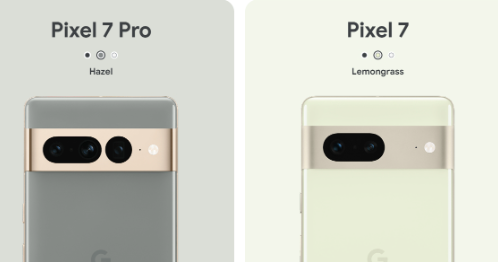The newest CPU created for Pixel phones, the Google Tensor G3, will make its debut in both the Pixel 8 and Pixel 8 Pro.
But how does the Tensor G3 stack up against the Tensor G2? In order for you to have a clear understanding of how the two chips will affect the new phones, we’ve prepared this comparison guide to highlight the main differences between the two chips.
Therefore, if you’re thinking about purchasing a new Pixel 8 phone and want to know what kind of performance you can anticipate compared to the Pixel 7, read on.


PU, AI capabilities, and improved RAM support, making it a more powerful and efficient chipset compared to the Tensor G2. Additionally, both chipsets continue to focus on AI-heavy tasks and come with dedicated security cores.
Google Tensor G2:
- Manufacturing Node: 4nm Samsung PLP
- CPU Cores:
- 2x super-big ARM Cortex-X1
- 2x big A78
- 4x small Cortex-A55
- GPU: Mali-G710 MP7
- Modem: Samsung Exynos 5300 5G
- RAM: LPDDR5
- Caches: 4MB CPU L3, 8MB system level
- Special Features:
- Panel-level packaging for reduced waste
- 2+2+4 core cluster configuration
- Improved GPU for better performance
- Dedicated security core for enhanced security and Trusty OS support
- Improved night sight image processing
- Unblur feature for fixing blurred images
- Improved speech recognition
- Focus on AI-heavy breakthroughs and personalized experiences in speech, photography, video, and security
Google Tensor G3:
- Manufacturing Node: 4nm Samsung PLP
- CPU Cores:
- 1x 2.91GHz (Cortex-X3)
- 4x 2.37GHz (Cortex-A715)
- 4x 1.70GHz (Cortex-A510)
- GPU: 7-core Mali-G715 GPU
- Modem: Samsung Exynos 5300 5G
- RAM: LPDDR5X
- Caches: 4MB CPU L3, 8MB system level
- Special Features:
- Improved CPU architecture
- Enhanced GPU (20% better performance)
- Improved machine learning with TPU
- Google’s custom TPU (Codename “Rio”)
- Google’s custom ISP (Codename “Callisto”)
- Advanced video capabilities (4K at 60FPS, AI-powered features)
- Improved wireless connectivity with Wi-Fi 7
- Optimized for efficient performance
Comparison:
- Manufacturing Node: Both Tensor G2 and G3 are manufactured on the same 4nm Samsung PLP process, indicating similar efficiency and power improvements.
- CPU Cores: Tensor G2 features a 2+2+4 core cluster configuration, whereas Tensor G3 has a more diverse core setup, including Cortex-X3, Cortex-A715, and Cortex-A510 cores, focusing on efficiency and performance balance.
- GPU: Tensor G3 incorporates a 7-core Mali-G715 GPU, offering improved performance compared to Tensor G2’s Mali-G710 GPU.
- RAM: Tensor G3 uses LPDDR5X RAM, potentially providing better memory performance than Tensor G2’s LPDDR5.
- Special Features: Tensor G3 introduces several enhancements, including an improved CPU architecture, advanced video capabilities, Google’s custom TPU and ISP, and better wireless connectivity with Wi-Fi 7. It is optimized for efficient performance, AI tasks, and camera capabilities.
In summary, Tensor G3 represents an evolution over Tensor G2, offering improved CPU, GPU, memory, and special features, making it a more capable and efficient chipset, particularly in AI-related tasks, video, and connectivity.
Pros of Google Tensor G3 over G2
- Has a smaller size transistor (4 versus 5 nm)
- Shows better (up to 35%) AnTuTu 10 score – 1081K vs 801K
- Announced 1-year later
- Has 1 more cores
- 6% higher CPU clock speed (3020 vs 2850 MHz)
- Better instruction set architecture


Tensor G3 is built on 4nm process
Chip manufacturers’ ability to decrease a processor’s production node and pack in more transistors is one of the primary reasons why CPU power increases year after year.
For this reason, Google reportedly shrunk the Tensor G3 to a 4nm process node, making it more compact and effective than the Tensor G2’s 5nm node.
Even if Google was unable to create an even smaller 3nm process like Apple did with the A17 processor, this improvement alone should improve performance for the Pixel 8 phones.
Enhanced AI powers
The main benefit of switching to the Tensor G3 chip in the Pixel 8 according to Google is the improvements in AI performance. This comes as no surprise considering Google’s long-standing preference for AI performance over sheer speeds.
According to Google, the Tensor G3’s machine learning model is 10 times more complicated than the Tensor G2, which powers the Pixel 7. This should enhance the performance of the AI-powered features that have made the Pixel phone so well-known.
For instance, the Google Pixel 8 should now be better at identifying spam calls, reducing background noise during calls, and making it simple to remove unwanted noises from recorded videos.
